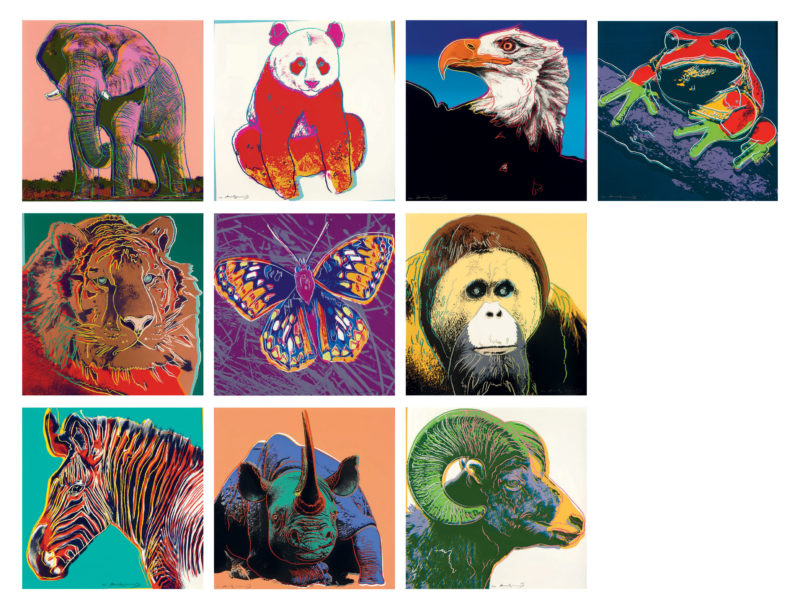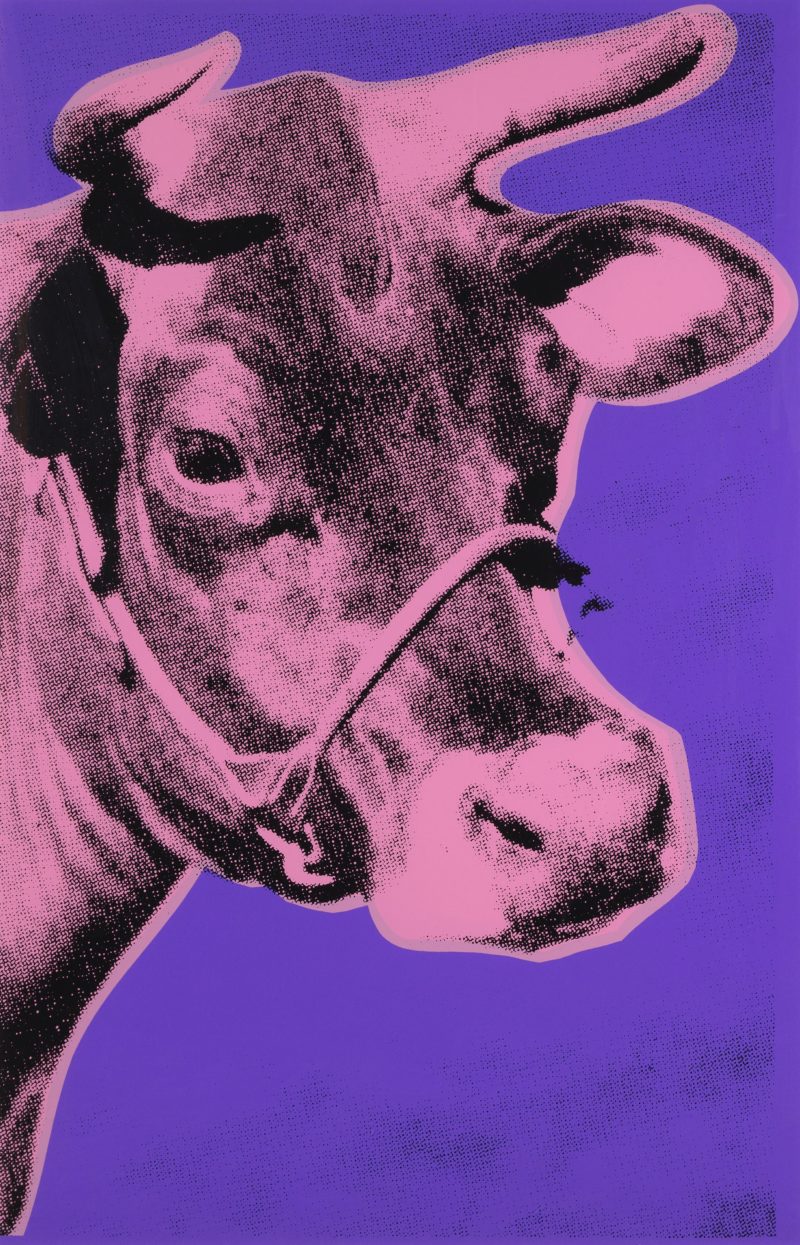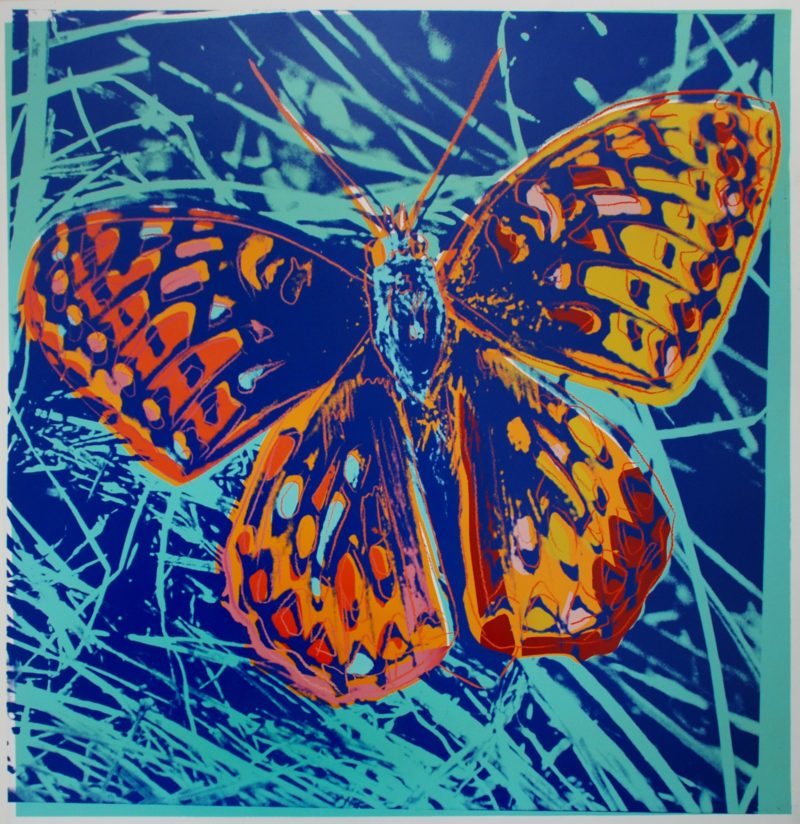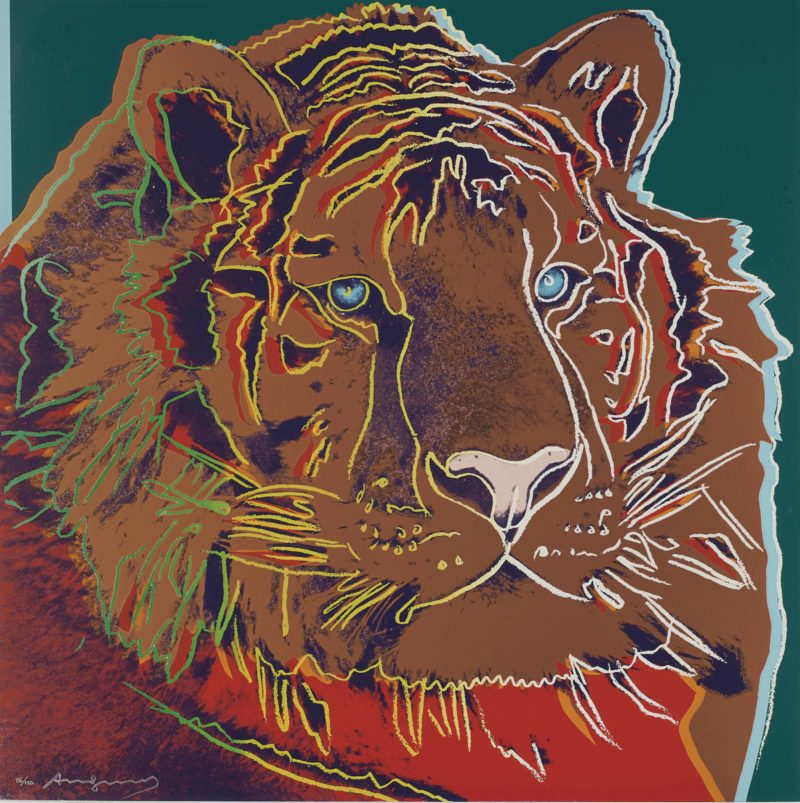
Introduction
Endangered Species is one of Andy Warhol’s 12 most influential artworks. It raises awareness of the situation of extinct animals around the world. Warhol created the entire project in 1983, at a time when he had mastered the concepts of capitalism and production. Prints of Endangered Species were exhibited in New York and sold at various fundraising awards. The idea for this groundbreaking project came after a passionate discussion with New York art dealers, who are also a husband and wife, Ronald and Frayda Feldman.
In the series, Warhol focuses on every animal from the Endangered Species Act of 1973 of endangered species. This act defined endangered species as a humanitarian matter, banned trade involving the endangered animals, and made steps to protect the animal’s original habitats. Like many other works by Andy Warhol, Endangered Species experienced significant success. This was probably owed to the ‘artist’s ubiquitously signature pop art 34 style and his focus on the use of specific colors.

10 Animals & Their star treatment
Endangered Species consists of ten silkscreen 5 prints of nearly extinct animals, trying to communicate the environmental issues to the audience. The series features ten of the highly endangered species from across the world including the:
| Artwork | Species status |
|---|---|
| African Elephant | Varied: Critically Endangered to Endangered |
| Bald Eagle | Least Concern |
| Black Rhinoceros | Critically Endangered |
| Bighorn Ram | Least Concern |
| Giant Panda | Vulnerable |
| Grevy’s Zebra | Endangered |
| Orangutan | Critically Endangered |
| Pine Barrens Tree Frog | Near Threatened |
| San Francisco Silverspot Butterfly | Not Evaluated |
| Siberian Tiger | Endangered |
The National Museum of Wildlife ‘Art’s described the Endangered Species series stating:
In a series of 10 paintings that echo each other in the issue of bright colors and are standardized in terms of size but are not multiples of the same image. Warhol draws attention to the rarity of these animals and gives each the “star” treatment.
This statement references Warhol’s preference for portraying superstars or other incredibly famous people such as Chairman Mao 6 in his infamous screen prints. He referred to his collection as “animals in makeup.”
Warhol’s interest in nature
Warhol’s interest in nature can be seen in most of his works. However, he never openly advocated preserving natural resources, vulnerable spaces, and endangered species. His love for animals is evident, telling from his other art projects like Cow and many photographs of cats 7, dogs 8, and other animals. This adoration for animals made it easy for him to create the Endangered Species.

Background
The calls for the preservation of endangered species began in the early 1960s. They gathered momentum throughout the 1970s until they reached a worldwide level in the 1980s due to dramatic declines in various animal species. The major causes of the decline were the loss of habitat, international trafficking, and toxic waste mismanagement.
As things got out of hand, Warhol responded the way he knew best; by using art. The effects of Endangered Species cannot be underestimated even today when discussing environmental preservation issues. Since the series was created, there has been a significant increase in the popularity of environmental art. Artists such as Ai Weiwei 910 has been using art to advocate for animals rights. At the same time, Ansel Adams was pivotal in raising awareness for the conservation and preservation of wilderness.
How about the status of the animals in 2019?
Of the ten animals in Endangered Species, eight remain endangered species, as two were removed in 1983 and 2007. Pine Barren’s tree frog was removed from the list of endangered species in 1983, shortly after the artist had created the series due to inaccurate data on the species.
The bald eagle was also taken off in 2007 because the species underwent massive recovery. The Sumatran Orangutan and the Black Rhinoceros are today in a precarious state of endangerment. The remaining ones, the Giant Panda, Grevy’s Zebra, Spot Butterfly, Callippe Silver, and Siberian Butterfly, are still endangered. The African Elephant and Bighorn Ram have been moved to the territory of vulnerability on the list as they have somewhat stable numbers.
The aftermath
The artist’s elevation of the series to pop culture status played a huge role in raising awareness of these species and funds for their preservation. Most of the prints were used for fundraising projects among many conservation groups.
The efforts to protect the Giant Panda have been the most successful. Even more, their conservation has led to unpredicted economic value to the communities that have the panda conservation compounds. According to a Chinese Academy of Sciences report, the preservation offers “great value for local people, culture and the environment, generating 20 times more money than the cost to conserve and maintain the cuddly bears.”
All this can be attributed to Warhol’s Endangered Species series. The artist propelled the efforts of conservation forward. The images in the series have a double-sword effect as they created awareness that the endangered animals need protection and increased the donations towards this course.
Vanishing Animals
With the success of Endangered Species, Warhol started to collaborate with others, most notably Dr. Kurt Benirschke of the San Diego Zoo. Together, they authored a book titled Vanishing Animals. Warhol’s contributions were a series of animals on the endangered list.
He provided 15 illustrations of species that were in danger of extinction, including Puerto Rican Parrot, Galapagos Tortoise, Mouse Armadillo, California Condor, Whooping Crane, Komodo Monitor, Sumatran Rhinoceros, La Plata River Dolphin, Paraguayan Peccary, Okapi, and Soemmerring Gazelle.

Warhol’s impact on environmental conservation can still be witnessed today, even after passing in 1987. Before he died, Warhol bought 15.1 acres of beachfront property in Montauk, Long Beach, which he left in a pristine condition. He arranged the ownership of the property to be transferred after his death to the Nature Conservancy. He also donated the Andy Warhol Preserve to be part of a land conservancy. He said:
I think having land and not ruining it is the most beautiful art that anybody could ever want to own.
The artist also owned a piece of land near Carbondale, Colorado, but he never put it to use, saying 1112:
I’m not going to build on it… It is too pretty… Land is the best art.
Analysis
The ten paintings look nearly as the animals are live and are not painted but printed, creating a material reality. Warhol used a specific process in which assistants could apply paint as well. He said 1314:
I wanted something…that gave more of an assembly-line effect.
Therefore, the prints ended up looking like mechanically reproduced photos in cheap tabloid newspapers.
Endangered Species contains some traces of Warhol’s previous works. He remixed certain principles used in his early works, such as the use of repetition and appropriation when doing mass production of the paintings. The appropriation in Endangered Species is similar to his celebrity paintings such as Ali, Mao 1516, Taylor, Mick Jagger, and Marilyn Monroe 1718 images. By doing this, the artist was looking to recreate objects of popular culture. With his great appeal, many people these days care about the endangered species.

Endangered Species is an outstanding work by Warhol. He used his Pop Art skills to his advantage and made it an avenue for activism. When the prints were exhibited, each had Warhol’s name in dominant red text, together with his image that “gives the impression that his head has been carved from a lump of marble 1920.” Warhol sent a grievous message about the endangered species. He summoned all of his skills and credentials to stop the war on wildlife animals.
There is no denying that Warhol’s brand had something to do with the success of the series, which stoke public interest. Also, the familiarity between the paintings in the series and his previous works made it easy for the public to be sold. It was a perfect combination of animals, even though the list wasn’t pre-planned.
Conclusion
With all of his contributions, there is no telling that Andy Warhol is one of the most valued artists in history. He used his skills for the benefit of society and the environment. When it came to addressing challenges, Warhol didn’t create intricate paintings that required a lot of imagination to interpret. By elevating the species to celebrity status, Warhol helped put immense pressure on different governments to step in and help protect the species. He used his status as a celebrity for the good of the environment worldwide.
Animals
In each species painting, Warhol accompanied it with interesting facts about the animal, something that garnered worldwide attention. He portrayed the following animals:
- African Elephant
- Bald Eagle
- Bighorn Ram
- Black Rhinoceros
- Giant Panda
- Grevy’s Zebra
- Orangutan
- Pine Barrens Tree Frog
- San Francisco Silverspot
- Siberian Tiger
African Elephant
The African Elephants can weigh up to seven tons and are the largest land animals. They can grow up to 4 meters (13 feet).


Bald Eagle
Warhol showcased many animals that are now endangered, but the bald eagle is the only one not in trouble right now. Due to the effect of shell-thinning from pesticide DDT and power-line electrocutions, the Bald Eagle population rapidly declined during the 1980s. Nowadays, better measures are in place, and you have more than 10000 pairs in the wild.


Bighorn Ram
The intriguing fact about the Bighorn Ram is that this animal was initially in the millions. The unreserved Bighorn rams are always in herds of 100 and over, providing them an impressive appearance. However, around the 1900s, the population covered just a few thousand specimens. Thankfully, numerous programs were focused on reducing hunting and helping the Bighorn Rams breed, and nowadays, you will notice that they have made a comeback in the wild. They are still one of the prime image icons for the natives.



Black Rhinoceros
The rhinoceros population has been in decline for a very long time, especially the black rhinoceros. The Black Rhinoceroses have a unique pointed upper lip and a dominant horn that is the main reason for its near extinction- the horn has medicinal use. The horns are said to be a potent aphrodisiac. Thus the high demands cause many rhinoceros to be killed each year. Thousands of black rhinoceros have been poached and killed to meet the high demands of the horns in the Asian market.
The effort to preserve the Black Rhinoceros is proving futile. When Andy Warhol made this print, the number of Black Rhinoceros was below 15,000. Thankfully some bans and better laws increased the number from 2410 rhinoceros back in 2004 to around 4880 in 2010, and the population is growing. They are still seen as an endangered species. In the 1960s, there were more than 70,000 animals out there. Now they are rare. The horns are pricier than gold, leading poachers to become more greedy and violent. Today, three subspecies of the black rhinoceros are entirely extinct.

Giant Panda
Giant Pandas are endangered, and they have been for a very long time. Around 1500 specimens can be found right now. A Giant Panda requires a lot of effort to conserve its species as it needs to consume more than 20 kilograms of bamboo leaves and shoots every day for adequate nutrients, which can last for a maximum of 16 hours. 2060 pandas live in the wild, and the IUCN (International Union for Conservation of Nature) considers them endangered and relatively close to extinction. The problem is that pandas are not reproducing frequently, and that makes them increasingly rare. As the population gets smaller, they still retain the same reproductive habits. Their habitat is slowly destroyed, and as the human population grows in China, they will have fewer and fewer places to live.
In China, conservation groups have taken advantage of the worldwide interest in preserving the pandas by establishing Giant Panda rental movements. These groups accept pandas from all around the world in exchange for some incentives, as reported by Environmental Practice: “In exchange for political favors or lucrative trade deals, the Chinese government offers countries around the world the opportunity to rent a giant panda. But this ‘opportunity’ comes with a hefty price tag: Hosting one panda can cost an enormous amount of money. Add to that the cost of proper zoo facilities and the annual cost to be fed and properly care for pandas, which can be up to $500,000 each annually.



Grevy’s Zebra
Equus grevyi, also known as Grevy’s Zebra, is the largest species in the horse family, with its unique stripes varying from one zebra to another. They live primarily in the plains in East Africa. Due to hunting, loss of habitat and unavailability of freshwater, the population of this species was declining rapidly. You can still find some Zebras on the northern side of Kenya and the south of Ethiopia. After the release of this print, legal action was taken, which is why Grevy’s Zebra are now legally protected in Kenya and Ethiopia.

Orangutan
Orangutans originally only lived in Asian countries like Malaysia and Indonesia, but they did end up expanding to other countries. The environmental problems now limit them to Sumatra and Borneo. The Sumatran and Bornean Orangutans are endangered, but the Sumatran one is even rarer than the other. These are very intelligent primates. Unfortunately, some people take them as pests and actively hunt them, making them another endangered species.



Pine Barrens Tree Frog
The Pine Barrens tree frog thrives in a more acidic aquatic environment. They have white and black streaks, and Warhol showcased them but in yellow and red. This one was listed as endangered by the US Fish and Wildlife Service due to habitat loss and no food source. While things improved a little bit, this is still a threatened animal.


San Francisco Silverspot
The Silverspot Butterfly is known for its outstanding beauty, though its number is still dwindling. Their name is related to their silver markings that can be found under the wings. Unfortunately, the Silverspot Butterfly has a habitat very close to the city, and the open areas where they thrived once are subject to urbanization. The Silverspot’s population declined because its only host plant, the Johnny jump-up, lost its habitat. There aren’t as many fields as there once were. There are also lots of animals destroying their habitat.



Siberian Tiger
Known as the Amur Tiger or the Siberian Tiger, this astounding subspecies is also one of the largest cats worldwide. At least in captivity, because the Bengal tiger is bigger in the wild. Despite that, the Siberian Tiger does have some unique adaptations that make it stand out quite a bit. They usually hunt solo and endure the harsh climate thanks to their dense fur and thick fat layer. You can find this animal on the eastern sides of Russia. Like many animals in this list, this one also dealt with threats from the human population. The IUCN (International Union for Conservation of Nature) classified this animal as endangered. In the 1990s, in particular, it was critically endangered. The lowest population was in the 1930s when it reached up to 30 specimens at most. According to the latest 2005 census, the population is around 360 and growing.


Sea Turtle
The Sea Turtle was not part of the Endangered Species series and created two years later in 1985. However, sea turtles are another endangered species. Warhol created this screenprint as a way to connect with the 1985 adaptation of the Russell Hoban Novel. Turtle 360A is the name of this blue and purple print and was published for the Turtle Diary 21 film in 1985. This film follows a couple from the UK that met each other for the first time at a Sea Turtle exhibit in the London zoo. Both of them think that it’s important to help turtles by releasing them into the sea.

More by Andy Warhol




![Andy Warhol's Maos - Everything you should know Andy Warhol – Mao [II.93], 1972, Screenprint, 36 x 36 inches, Edition of 250](https://publicdelivery.org/wp-content/uploads/2019/05/Andy-Warhol-Mao-II.93-1972-Screenprint-36-x-36-inches-Edition-of-250.jpg)
